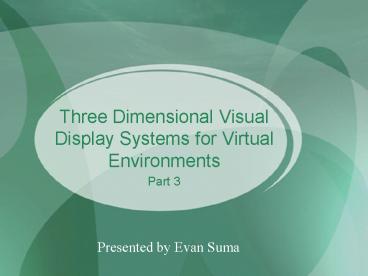Three Dimensional Visual Display Systems for Virtual Environments - PowerPoint PPT Presentation
1 / 32
Title:
Three Dimensional Visual Display Systems for Virtual Environments
Description:
Part 3 Presented by Evan Suma Parallax Barrier Vertical slit plate Blocks part of the screen from each eye Screen displays images in vertical strips Parallax Barrier ... – PowerPoint PPT presentation
Number of Views:133
Avg rating:3.0/5.0
Title: Three Dimensional Visual Display Systems for Virtual Environments
1
Three Dimensional Visual Display Systems for
Virtual Environments
Part 3
- Presented by Evan Suma
2
Parallax Barrier
- Vertical slit plate
- Blocks part of the screen from each eye
- Screen displays images in vertical strips
3
Parallax Barrier
- More than two images can be displayed
- Creates multiple views from side to side
4
Parallax Barrier
- Horizontal res display res / of 2D views
Multiple projecting monitors can be used to
maintain higher horizontal resolution.
5
Parallax Barrier Drawbacks
- Not commonly used
- Barrier blocks most of light to eye
- Causes dim image
- Small slit widths can result in diffraction of
spreading light rays
6
Parallax Barrier Diffraction
- Angular spread of light through slit of width a
is approximatelywhere ? is the wavelength of
light passing through the slit
? 2 asin ( ? / a )
a pitchslit / N
7
Parallax Barrier Diffraction
- More diffraction than lenticular display
- Caused by loss of directivity of barrier
- Parallax barrier is only a fraction of lenticular
pitch
8
Parallax Barrier Brightness
- Reduce light which reaches eye
- where B0 is brightness of unblocked screen
Brightness B0 ( a / pitchslit )
9
Parallax Barrier Rate and Bandwidth
- Horizontal resolution is reduced(same as
lenticular displays) - Bandwidth must be increased to maintain high
visible resolution - Or sacrifice other parameter
- Vertical resolution
- Refresh rate
10
Parallax Barrier Rate and Bandwidth
- Horizontal resolution is reduced(same as
lenticular displays) - Bandwidth must be increased to maintain high
visible resolution - Or sacrifice other parameter
- Vertical resolution
- Refresh rate
11
Slice Stacking
- Building a 3D volume by layer 2D images
- Also called multiplanar displays
- Rather than use a planar mirror, a variable-focus
mirror can be used
12
Slice Stacking
- Common method uses acoustics
- Vibrates a reflective membrane
- Causes focal length to change
- Uses reflection from monitor
- Over time forms a truncated-pyramid viewing volume
13
Slice Stacking
- Traces out a luminous volume
- Objects are transparent
- Objects further in depth cannot be obscured
14
Slice Stacking
- Ideal for volumetric data sets and modeling
problems - Poorly suited to photographic or realistic
images with hidden surfaces
15
Slice Stacking Resolution and FOV
- Spatial resolution and FOV the same as underlying
2D display - Varifocal mirrors limited to approximately 20
inches due to acoustic and mirror characteristics
16
Slice Stacking Depth Resolution
- Depth of reflected CRT is constantly changing
- Very fine resolution of depth spots can
potentially be imaged - Limited by bandwidth of CRT and persistence of
phosphors
17
Slice Stacking Accommodation
- One of the few displays that support ocular
accommodation - Actually displays points in 3D space either
directly or optically
18
Slice Stacking Refresh Rate
- Refresh rate is twice frequency of vibration
- Typically 30 Hz signal drives mirror
- Results in 60 Hz refresh rate
19
Slice Stacking Brightness
- Short persistence phosphors must be used
- Prevents smearing of image in depth
- Brightness somewhat reduced from typical 2D
display - Phosphors of short enough duration only available
in green (circa 1986)
20
Slice Stacking Viewing Zone
- Viewing zone limited by position of display CRT
- Obstructs viewing zone
- Can use beam splitter to move CRT below, but
lowers brightness by at least 75
21
Slice Stacking Viewing Volume
- Magnification of mirror changes size of reflected
CRT - Results in truncated pyramid volume instead of
rectangle
22
Slice Stacking Volume Extent
- Mirrors have leverage of approximately 85
- Distance h in mirror
- Movement 85h in reflected image
23
Slice Stacking Number of Views
- Number of views essentially unlimited
- Horizontal and vertical parallax are both
supported
24
Holography CG Stereograms
- Recorded optically from a set of 2D views of a 3D
scene - Projects each 2D image into a viewing zone
- Stereo views with horizontal parallax
- Full-color, high resolution images
- Non-real time
- Requires a huge amount of information (100-300
views)
25
Holography CG diffraction patterns
- Generates a diffraction pattern
- Hologram creates a 3D wavefront when illuminated
- Images 3D objects and light sources in space
- Traditional methods were complex and
computationally expensive - New method (circa 1992) allows generation to be
displayed in real-time
26
Holography Spatial Resolution
- Very high horizontal resolution is needed
- Vertical resolution can be lower
- High horizontal resolution is not resolution of
displayed holographic image - Horizontal resolution of image points is
diffraction limited - Beyond human perceptual limits
27
Holography Miscellaneous
- Like slice-stacking displays, holograms support
ocular accommodation - Good brightness and contrast using low-power
laser (a few milliwatts) - Both monochromatic and color have been
demonstrated - Very high bandwidth compared to other systems
28
Holography Miscellaneous
- Depth resolution is beyond human perceptual
capabilities - Provides many views from side-to-side
- No vertical parallax
- Viewing zone angle is determined by the frequency
of diffraction pattern - MIT systems depth range limited to approximately
100mm - MIT systems refresh rate is 36 Hz with a little
flicker
29
(No Transcript)
30
(No Transcript)
31
(No Transcript)
32
Any Questions?































